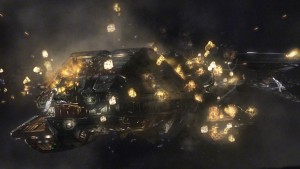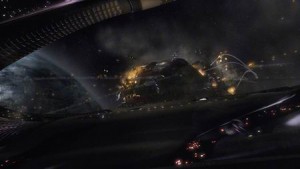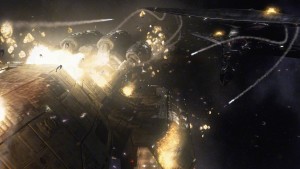This week we honor winners of 2007 Emmy Awards, starting with Atmosphere Visual Effects for their amazing work on Battlestar Galactica. The work is all the more exceptional considering it is episodic television – done week in, week out. Coming up later in the week, we’ll speak to other category winners from this year’s outstanding collection of Visual Effects submissions.

Atmosphere Visual Effects has won this year’s Emmy Award for “Outstanding Special Visual Effects for a Series†for Sci-Fi Channel’s Battlestar Galactica (NBC Universal) season three episode “Exodus, Part 2.â€
The winning creative team for Atmosphere includes:
Jeremy Hoey, Lead Matte Painter
Tom Archer, Lead Compositor
Andrew Karr, CGI Supervisor
Alec McClymont, Lead CGI Artist/Animator
Brenda Campbell, Lead Compositor
The winning Battlestar creative team includes:
Gary Hutzel, VFX Supervisor
Michael Gibson, Senior VFX Coordinator
Doug Drexler, CG Supervisor
Adam “Mojo†Lebowitz, CGI Sequence Designer
“Exodus, Part 2†featured the dramatic and dangerous rescue of the colonists from the Cylon-occupied surface of the planet New Caprica and an eye-arresting, explosive space show down between the Battlestars “Galactica†and “Pegasus†and Cylon Base Stars, which ends in fiery triumph and destruction.
“After a decade of being consistently and prominently honored with Emmy Awards nominations for visual effects,†says Atmosphere principal Jeremy Hoey, “this is the first time a Vancouver-based show has brought the award home. We at Atmosphere are proud to share in this award and to take part in such an outstanding production as Battlestar Galacticaâ€

fxg: What applications are used in your pipeline – could you walk though the main workflow?
Atmosphere : In Battlestar Galactica, we have used Lightwave for most of the CG and digital set extensions, the only exception being the Cylon Centurions, which we converted to a Maya/Mental Ray pipeline back in Season II.
For standard CG, like spaceships and the like, we employ a multi-pass rendering pipeline that uses ambient occlusion renders to simulate global illumination, with separate ambient, keylight, reflection, secularity, luminosity, and z-depth passes. This gives the compositors a great deal of flexibility while keeping render times relatively sane.
For the Cylon Centurions, we found that only true HDRI-based techniques could make those shiny surfaces sit believably in the environment. We take bracketed still images on set with a fisheye lens, and stitch those
together to form the basis for image-based lighting and reflections in Maya. The Mental Ray render engine produces exquisite results.
fxg: Can you explain the role of previz and online temps in a highly visual effects show like Battlestar?
Atmosphere : Previz is critical – there is often very little time at the back end of the post schedule to actually execute the final visual effects, so it’s very important that they be carefully planned so there are as few surprises as possible.
For that same reason, though, Battlestar tends not to have a Temp VFX deadline like some other shows we’ve worked on. With a compressed Post schedule, there often simply isn’t time to get working versions to Editorial to cut in, so we end up going straight from previz to close-to-final versions. That can get hairy, but it’s sometimes the only way you can meet the deadline!
fxg: How long per ep do you normal have to work on a show?
Atmosphere : It varies – sometimes as little as 10 days, sometimes over a month. On “Exodus Part II†we had just under a month.

fxg: Did this Emmy winning ep present any special issues?
Atmosphere : Too many shots, too little time! Battlestar Galactica is created in a very dynamic fashion, with the producers tweaking and adjusting until quite close to the end of the post-production cycle. So we had our work cut out for us to create some of these shots in fairly short order.
So given this kind of schedule, the biggest challenge was definitely the destruction of the Pegasus – the shots in that sequence were big, complex, and took a very long time to render with hundreds of layers of CG per shot. The compositing department in particular took a real beating getting the shots completed in time.
fxg: In Exodus Part 2 you needed to take a Battlestar into the atmosphere – what challenges did this present?
Atmosphere : We had to do quite a bit of digging around to try to figure out what the “re-entry†might look like – and that wasn’t as easy as you might think. We’ve seen various versions of it in numerous movies over the years, but there isn’t any actual real-world close-up footage of spacecraft entering the atmosphere. So, like those movies’ effects, ours had a healthy dose of educated guesswork involved.
In top of that, we had to imagine what would happen when the Battlestar “jumped†out of the atmosphere – we decided that it would leave a large vacuum that the surrounding air and superheated plasma would immediately implode back upon. It was just too cool an idea to pass up, so it turned out to be a really fun sequence to pull off!
In the end, we employed a bunch of tricks to get the look we wanted – 3D particles, dynamics, and old-fashioned warping and glowing in comp.
fxg : How many effects shots in this episode?
Atmosphere : There were about 75 visual effects shots in this episode.
